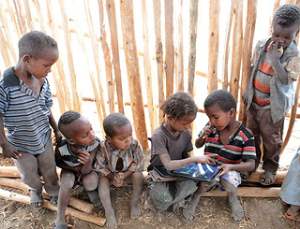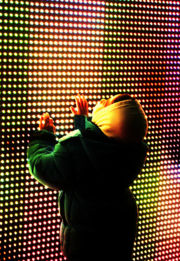Education/Student-directed learning
The model of education in 20th century school systems involves one teacher, who is supposed to have all the knowledge in his or her head, imparting knowledge to thirty or so students, who are more or less passive receptacles of the teacher's knowledge.
One obvious disadvantage of the teacher-and-class situation is that there are thirty catchers and only one pitcher. Just as no one could be expected to play thirty different musical instruments at the same time, no one can tailor their communication to thirty different listeners at the same time. So in the classroom thirty heterogenous nervous systems are exposed to one homogenous stimulus, all at the same rate. Of course, the chance that all the students will understand the material at exactly the same rate and in exactly the same way is zero. Inevitably, some fall behind and get frustrated, others race ahead and get bored, and it doesn't matter how good the teacher's intentions are; nothing can be done within the classroom model to accommodate these students. Flexibility, customization, each student learning at a pace that is correct for him or her — these things simply are not possible in the classroom model. But they are possible in a situation where each student explores educational materials for her- or himself.
This is the essence of the Montessori Method  : children are put in contact with good educational materials and their natural curiosity is allowed to do the work. The child's learning is directed by their own inner passion and inquisitiveness, it proceeds at the child's own rate, according to their own interests. Boredom is therefore impossible. There is no 'teacher' as such, though there may be a supervisor who can answer the students' questions and handle any problems that may arise. Montessori-educated children consistently have higher cognitive and social abilities than conventionally-educated children[1].
: children are put in contact with good educational materials and their natural curiosity is allowed to do the work. The child's learning is directed by their own inner passion and inquisitiveness, it proceeds at the child's own rate, according to their own interests. Boredom is therefore impossible. There is no 'teacher' as such, though there may be a supervisor who can answer the students' questions and handle any problems that may arise. Montessori-educated children consistently have higher cognitive and social abilities than conventionally-educated children[1].
Conventional education underestimates the power of a child's playful curiosity about the world. A child is the most sophisticated learning machine in the known universe. Put a child in a room with nothing but a piano, come back three months later, and you would expect that the child will be able to play the piano. An experiment called The Hole In The Wall project has been done in which computer-booths were left in some of the poorest areas in India. There were no teachers or other intervention, just a computer put in contact with children. The findings give strong support for self-directed learning; the children's academic performance consistently doubled or quadrupled, the children learned 200 words of English vocabulary in three months and they became computer-literate within days. Sugata Mitra's TED talk gives more detail. As with the Montessori method, there is no teacher, but children learn by themselves and teach each other in groups. Sugata Mitra is currently researching whether the method can be extended to cover an entire educational curriculum. His research aims to answer the question of whether groups of children can complete their schooling on their own, without a teacher.

With cheaper computer technology and the sort of optimized teaching materials described above, this is likely to become the preferred method for education in poor countries. It could be applied to students of all ages.
